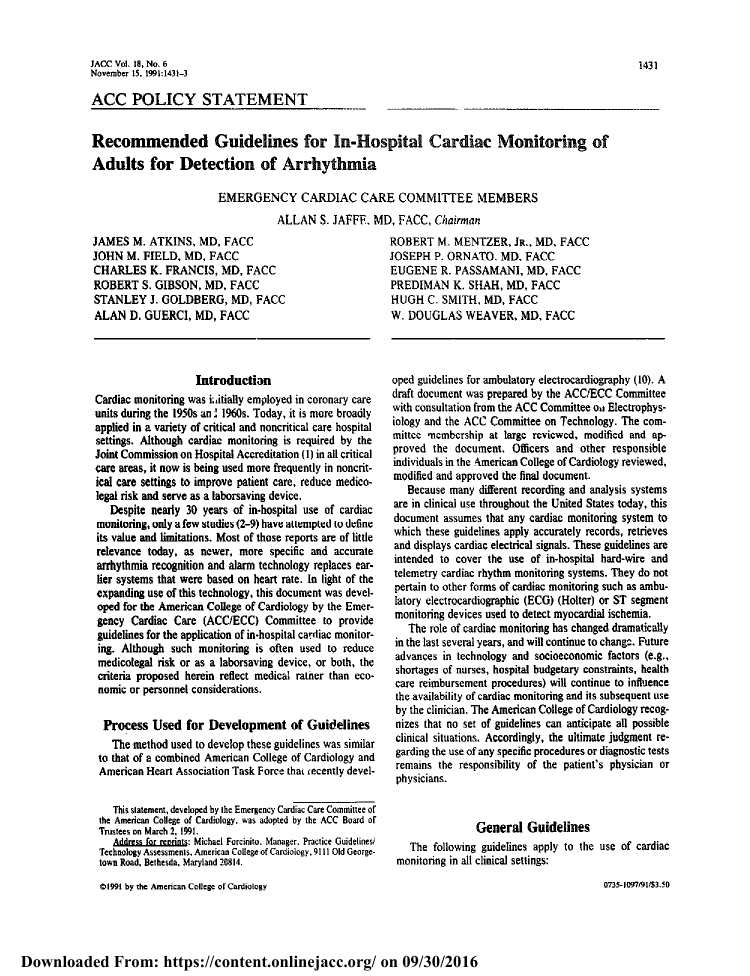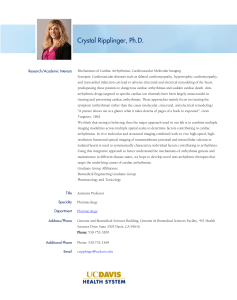Recommended guidelines for in-hospital cardiac monitoring of
advertisement

JllCC “0,. 28. NO. 6 Novcmbu 15. 1591:10115 ACC POLICY STATEMENT .___ Recommended Guidelines for InAdults for Detection of Arrhyth EMERGENCY CARDIAC ALLAN CARE COMMITTEE MEMBERS S. JAFFF. MD, FACC. Chnirmon JAMES M. ATKINS, MD, FACC JOHN M. FIELD, MD, FACC CHARLES K. FRANCIS, MD, FACC ROBERTS. GIBSON, MD, FACC STANLEY I. GOLDBERG, MD, FACC ALAN D. GUERCI, MD, FACC ROBERT M. MENTZER. JR.. MD, FACC IOSEPH P. ORNATO. MD. FACC EUGENE R. PASSAMANI, MD, FACC PREDIMAN K. SHAH, MD, FACC HUGH C. SMITH. MD, FACC W. DOUGLAS WEAVER, MD. FACC Intmductim Cardiac monitoring was i:&lly employed in coronary care units during the 1950san : 1960s.Today, it is more broadly applied in e variety of critical and noncritical care hospital settings. Although cardiac monitoring is required by the Joint Commission on Hospital Accreditation (11in all critical care areas, it now is being used more frequently in noncritical care settiogs to improve patient care. reduce medicolegal risk nod serve as a laborsaving device. Ikspite newly 30 years of in.hospital use of cardiac monitoring, only a few studies (2-P) have attempted to define its value and limitations. Most of those reports are of little relevance today, as newer. more specific and accurate arrhythmia re&ilion and alarm technology replaces earlier systeow that were based on heart rate. In light of the expattdiog use of this technology, this document was developed for the American College of Cardiology by the Emergency Cardiac Care (ACC/ECCl Committee to provide guidelines for the application of iwhoapital wdiac monitoring. Although such monitoring is often used to reduce medicolegal risk or as a laborsaving device, or both, the criteria proposed herein reflect medical ratoer than economic or personnel considerations. Process Used for Development of Guidelines The method used to develoo these mtidelines was simdar to that of e combined Am&m Coll& of Cardiology and American Hean Association Task Force thaclccendy devel- di document was preparedby the ACCfECC Committee with consultation from the ACC Committee 01 Electrophysiology and the ACC Committee on Technology. The committee wmbership at lage reviewed, modified and ap proved the document. Officers and other responsible individuals in the 4mericao College of Cardiology reviewed. modified and approved the final document. Because many d&rent recording and analysis systems are in clinical use throughout the United States today, this document assumesthat soy cardiac monitoring system to which these auidelines aoolv accurately records. retrieves and displays &diac els&l signals. These guidelines are intended to cover the use of in-hospital hard-win and telemetrv cardiac rhvthm monitorine svstems. Thev do not pertain to other for& of cardiac m&&ring such is ambulatorv electrowdioemohic (ECG) (Holterl or ST semoent monitoring devices %I to detect myocadial ischerm’a. The role of cardiac monitoring has changed dmmatic@IIy in the last severalyears, and will coodnue to chaogr. Future advances in technology and soeioecooomic factors (e.g.. shortages of nurses, hospital budgetary constraints. health care reimbursement procedures) till continue to influence the availability of cardiac monitoring uld its subsequent use by the clinician. The American College of Cardiology I’CCOSnizes that no set of guideliocs can anticipate all possible clinical situations. Accordingly. the ultimate judgment regarding the use of any spcific procedures or diagnostic tests remans the responsibility of the patient’s physician or physicians. General Guidelines The follomng guidelines apply to the use of cardiac monitanng in all clinical settings: Downloaded From: https://content.onlinejacc.org/ on 09/30/2016 I. There mm be adesuate human surveillance of the rn~nax~24hours B day b; medical. nursing or paramedical personnel lmoniior watchers) tramcd and qualified tn the &CC recognition of clinically signiftcant cardiac rhythm disturbances. In general. the degree of human surveillance requared is inversely related to the sophisticaoon and reliability of the cardiac monitoring equipment used. 2. Aooroorialelv trained physicians and nurses must be respons;ble ior de&ma rc~&Iing the use of cardiac monitormg in each hospital clinical area with these devices in USC. Thcsc indn’iduals must determine: a) the specific degree of monitorins surveillance that is appropriate for each clinical area: b) the minimal qualification and traming standards of personnel assigned to monitor wveillance duties: cl the protocols and procedures ior responding to common arrhythmias. dl the unit-specific indications for initiation and discontinuation of cardiac monitoring. 3. Adequate nun;bers of trained medical personnel cphysicians or nurses, or both) mutt be present or immediately available to treat important. life-threatening arrhythmias detected by the system The lack of available personnel to promptly detect or treat arrhythmias expeditiously should r&e questionr concerning the indications for surveillance. Clinical Indications for Cardiac Monitoring No nublished clinical studies have ertabbshed firm criteria for in-hospital cardiac monitoring. Accordmgly. the folIowog rating system was devised by Ihe ACC-KC Committee to classify the more common clinical conditions for which such monitoring is currently being applied. Assignment of common clinical situations to each of the categories in this document retiects the opinions of the ACC-ECC members. Class 1. Cardtac monitoring is indicated m most if not all such patients. Class II. Cardiac monitoring may be of benefit in some patients but is not considered essential for all. Class 111. Cardiac monitoring is not indiealed because the patient‘s risk of a wious arrhythmia is so low that monitor. ing is not of therapeutx benefit. The ACC recognizes that. gwcn the diversity of uses for cardiac monitormz?. a comorehensive IiStine of the orecise usefulnas of rnooFlonng in’every clbncal s&lion isimpossible. There may be situations in which a wtient ma class I category may nor destre or require m&oring and other circumstances in which a patient in class Ill may be appropriate for cardiac monitoring because of the complexny of managing his or her medical problems. The period of time that cardiac monitorine serves a clinicallv useful ouroose is highly variable and muit be individualizei by the &n&n to meet each specific patient‘s needs. The gutdehnes are intended to b&n to define the medical indications for inhospital cardiac monitoring. They were nor developed for use as guidelines for reimbursement. medic&gal considerations, quality assurance or the definition of when monitor- ing can or should he used to substitute for medical or nursing personnel. or bo!h Such considerations are important bul are beyond Ihe scope of this document. Guidelines classifying the use of cardiac monitoring for i variety of common clinical situations follow: Class I Cardiac monitoring is indicated in most if not all patient! in this group. This category includes all patients who arc a rig&cant risk of an immediate. life-threatening arrhythmia I. Early hospital phase (from arrival in the emergew department through the 1st 3 days) of patients with initialI) suspected and subsequently proved acute myocardial infarc tion. This period will be longer for patients with clinicall! important complications (e.g.. significant arrhythmias. con duction defects. silent ischemia. pomp failure, shwkl. 11 general. patients with such complications need to be moni tored for s2 days after the complicatton has been correctec or controlled ,sec class II). 2. Patients suspected of having acute myocardial infarc lion on the basis of clinical or ECG criteria, or both Monitoring is continued until infarction can be excluded. 3. Owing surgery and early c~nvalescenee (postoperative care unii period and for the 1st 3 days) of all patients wb have undergone cardiac surgery. including those who re ceivc an automated internal cardioverter defibrillation (ICD system. This period will be longer for patients with clinicall important complications (e.g.. significant arrhythmias. seri ous conduction defects. pump failure. shock). In general patients with such complications need to be monitored fo a2 days after the problem has been corrected or controlled 4. Patients who have been resuscitated recently fmn cardiac arrest or those documented directly or indir&tly 1~ be at risk for cardiac arrest (e.g.. patients with Mobile typ II hean block or greater, new onset high degree heart block runs of sustained ventricular tachycardia or new onre intraventricular conduction defects. 5. Most critically ill medical or surgical patients requirin care in mlensive care units. This group in&des, but-is ne limited to. those patients who are in hemodynamicall unstable condition or who are undergoing mechanical ven tilation. 6. During the acute phase of management of patients wh have been poisoned wilh drugs or chemicals at doses know or suspected to have cardiac arrhythmic toxicity (e.g tricyclic antidepressants. phenothiarines. digitalis. antia! rhythmic drugs). 1. During the acute ohase of mvocarditis. 8. During initiation.and loading of type I or type II antiarrhythmic drugs for potentially life-threatening arrhytt mia, in patients clinically prone to proarrhythmic effects. 9. Immediately after percuraneous tmosluminal comnar angioplasty for patients with cornplicaiions of the pmcedur (e.g.. coronary artery dissection or thrombosis). Monitorin Downloaded From: https://content.onlinejacc.org/ on 09/30/2016 should continue until the rratient’s condition has been stable for at least 24 h. IO. Patients with unstable anaina: monitor& is coniinued until the patients is in stable condition (not ne&ssarily pain free). It. Patients with high risk coronary artery lesions (e.g.. high grade left main coronary artery disease or its equivalent) who are candidates for. and who will undergo. urgent mechanical revascularization. 12. Patients treated for arrhythmias by catheter ablation. CIOSS II Cardiac monitoring may be of benefit in some patients but is not essential for all. 1. Patients with acute myowdiel infarction after day 3. especially those suspected to be et higher risk for ventricular librilkdion such as those with anterior wall Q wave infarction, conduction defects or the complications of infarction indicated in class I-I. Patients with no complications. nontramural events or nonanterior wall infarction are at lower risk. 2. Patients with potentially lethal arrhythmias several days after initial control of the arrhythmia. 3. Patients who. becauseof theirunderlvinadiaease state. ere deemed by the physician to be et s~gn%cent nsk for cardiac arrest. respiratory arrest or the development of hypotension. 4. Patients with clinically significant nonlife-threatening arrhythmias (e.g., atrial fibrillation) who. because of severe underlying cardiac dysfunction, are considered to be et incnased risk for pmenhythmic effects during initial treat- 1 Postoprralivr patients who ax tions that do not irwolve cardiopulmonary bypass. 2. Obsretric ~1dtien% except for those with sieniticant medical (erpeciaHy cardiovasc&l conditions or&e who develop the cardiovascular difficulties defined in class l or II. 3 Patients who have a temdnal illness and who are not candldater for (be lreetmenf of arrhythmias thet may be derected. Many. but not necessarily ell patients with a “do not resuscitale” designation mr~y fit into this caregory. 4. Patients eho have undergone routine. uncomplicated coronary angiography. 5. Pati:ntr with chnnic. stable atrial fibrillation. 6. Patients wth sroble asymptomatic premature ventricular conlrections or nonsosrained ventricular tachycardia who are honpatalired for rearonr other than cardiac or hemodynamic compromise. i. i’anenl~ whose underlying cardiac disease has been rtahd,zdd and who have had 10 arrhythmias on 3 consecuwe days of monitoring. 5. Patients with suspected or proved hemodynamically signiftwmt paroxysmal tachyarrhythmias or hradyarrhythmice. 6. During the acute phase of pericerditis when myorarditis is not clinically evident. 7. Patients who are being evaluated for unexplained syncape or other transient neurologic signs or symptoms that migltt be due to a cardiac arrhythmia. 8. Immedialely after percutaneous tram’. -inal coronary angioplasty. 9. During the tst48 to 72 h. patients in whom a permanent pacemaker and lead system has been implanted. IO. Patients in stable condition after cardiac surgery. Class at tow risk. such as young pat~entc after relatively simple uncomplicated opera- III Cardiac monitoring is not indicated because the patlent’s risk of a serious arrhythmia or the likelihood of thenpeutic benefit is low. Downloaded From: https://content.onlinejacc.org/ on 09/30/2016 References



